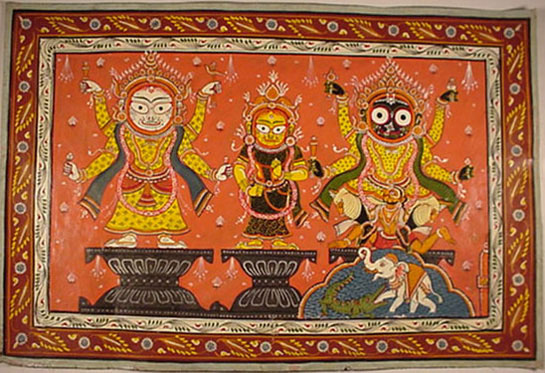I just came across this news piece on TOI about the spread of Odia arts in India. Its really a sad situation that no concrete efforts are being made by the Odisha government to promote the culture and arts of our rich land. Odisha has so many things to offer to the world, but except Odishi dance, nothing is known about Odisha. The following news made me happy that at least people from out of Odisha are inviting our artists to learn our arts. Here is how Indira Gandhi Rashtriya Manav Sangrahalaya (IGRMS), Mysore has taken the initiative.
A learning camp about the traditional Odisha painting style known as Pattachithra is planned by the Indira Gandhi Rashtriya Manav Sangrahalaya (IGRMS). Artists from Odisha have been roped in to train Mysoreans on preparing various Odisha art forms. Pattachithra is a traditional art form using textile design that focuses on religious subjects like the Jagannath of Puri, Vaishnava culture and Krishna and Radha or subjects from nature like fields, farms, valleys and waterfalls. The training programme is spread over a ten day period.

Pattachitra does not make use of regular colours. Poster colours, water colour, acrylic, crayons, charcoal and oil paints have no place here. Instead, colours in Pattachitra are prepared by traditional methods and include a range of raw materials like vegetables, stones and minerals. Pattachitra's whites, for example are made from conch shells. The shells are powdered, boiled and then filtered before they can be used. Reds come from Hingula, a mineral, a yellow stone, known locally as haritala is ground to provide yellow pigments. For blacks, pattachitra practitioners use a dye made from burnt coconut shells. Traditional Pattachithra paintings use a limited set of colours: red, yellow, indigo, black and white.
Participants in the programme will learn to prepare different colours and learn colour-mixing techniques. They will learn how to convert normal colour into water-proof colours. After successful completion of the training, candidates will be issued a central government certification. They will also be able to take home the the paintings they create during the course of the training. "Mainly, Patachithra paintings were made on cloths. The name itself reveals the form of art. Pata means cloth, and Chithra means art in Sanskrit. Traditionally, pattachitra was a family undertaking. The men folk did the artwork and the women worked on preparing the dyes" says Nagendra from Southern Regional Centre of IGRMS.


No comments:
Post a Comment